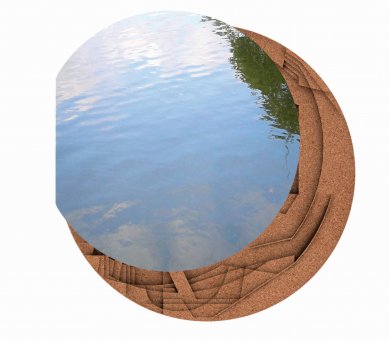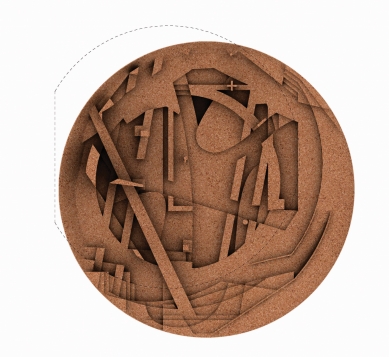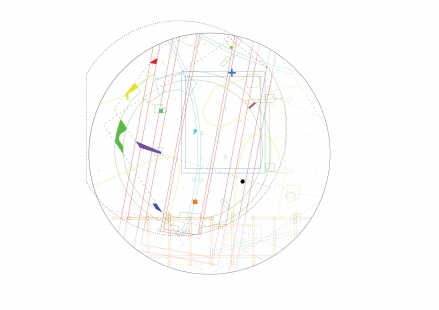
Návrh letního pavilonu Serpentine Gallery 2012 od H&deM a Ai Weiwei
Od únorového sdělení londýnské galerie Serpentine, že autory jejich letošního pavilonu bude basilejská dvojice H&deM s čínským umělcem Ai Weiwei, se netrpělivě očekává jakou podobu budou mít ohlášené 'výkopové práce odhalující zbytky předešlých pavilonů'. Zároveň se jedná o jubilejní čtyřstý projekt švýcarského dua Jacques Herzog & Pierre de Meuron, jejichž profesní kariéra přesahuje tři dekády.
Půdorysnou stopu nového pavilonu má tvořit směsice jedenácti dřívějších objektů prezentovaných zde jako odhalené základy obalené korkem, čímž vznikla jedinečná 'archeologická krajina.' Volba korku padla z důvodu jeho ekologičnosti a také vizuální podobnosti s odkrytou zeminou. Postupnou cestou pod zem se budou návštěvníci dostávat hlouběji do historie a získávat obraz předchozích pavilonů. Jedenáct sloupů rozmístěných pod úrovní trávníku upomíná na minulé stavby a nový dvanáctý sloup bude podpírat zrcadlovou střechu vznášející se 1,4 metru nad trávníkem.
V průběhu léta bude pavilon již tradičně sloužit jako místo řady společenských a kulturních událostí, přičemž za vrchol je vždy považován rozhovorový maraton Hanse Ulricha Obrista, který s touto myšlenkou začal před sedmi lety (2006 - 24-hour Serpentine Gallery Interview Marathon, 2007 - Experiment Marathon, 2008 - Manifesto Marathon, 2009 - Poetry Maratho, 2010 - Map Marathon, 2011 - Garden Marathon, 2012 - Serpentine Gallery Memory Marathon).
Letní pavilon v londýnském Hyde Parku se veřejnosti otevře již 1. června 2012 a bude přístupný až do 14. října 2012. Poté pavilon přejde do vlastnictví Usha a Lakshmi N. Mittalových, kteří jej zakoupili do svých soukromých sbírek.
Více informací >






“Every year since 2000, a different architect has been responsible for creating the Serpentine Gallery’s summer Pavilion for Kensington Gardens. That makes eleven Pavilions so far, our contribution will be the twelfth. So many Pavilions in so many different shapes and out of so many different materials have been conceived and built that we tried instinctively to sidestep the unavoidable problem of creating an object, a concrete shape.
Our path to an alternative solution involves digging down some five feet into the soil of the park until we reach the groundwater. There we dig a waterhole, a kind of well, to collect all of the London rain that falls in the area of the Pavilion. In that way we incorporate an otherwise invisible aspect of reality in the park – the water under the ground – into our Pavilion. As we dig down into the earth we encounter a diversity of constructed realities such as telephone cables and former foundations. Like a team of archaeologists, we identify these physical fragments as remains of the eleven Pavilions built between 2000 and 2011. Their shape varies: circular, long and narrow, dots and also large, constructed hollows that have been filled in… These remains testify to the existence of the former Pavilions and their greater or lesser intervention in the natural environment of the park.
All of these foundations will now be uncovered and reconstructed. The old foundations form a jumble of convoluted lines, like a sewing pattern. A distinctive landscape emerges out of the reconstructed foundations which is unlike anything we could have invented; its form and shape is actually a serendipitous gift. The three-dimensional reality of this landscape is astonishing and it is also the perfect place to sit, stand, lie down or just look and be amazed. In other words, the ideal environment for continuing to do what visitors have been doing in the Serpentine Gallery Pavilions over the past eleven years – and a discovery for the many new visitors anticipated for the London 2012 Olympic Games.
On the foundations of each single Pavilion, we extrude a new structure (supports, walls) as load-bearing elements for the roof of our Pavilion – eleven supports all told, plus our own column that we can place at will, like a wild card. The roof resembles that of an archaeological site. It floats a few feet above the grass of the park, so that everyone visiting can see the water on it, its surface reflecting the infinitely varied, atmospheric skies of London. For special events, the water can be drained off the roof as from a bathtub, from whence it flows back into the waterhole, the deepest point in the Pavilion landscape. The dry roof can then be used as a dance floor or simply as a platform suspended above the park.”
Cork is a natural material with wonderful haptic and olfactory qualities with the versatility to be carved, cut, shaped and formed, as demonstrated in many historical examples of cork architectural models.”
Půdorysnou stopu nového pavilonu má tvořit směsice jedenácti dřívějších objektů prezentovaných zde jako odhalené základy obalené korkem, čímž vznikla jedinečná 'archeologická krajina.' Volba korku padla z důvodu jeho ekologičnosti a také vizuální podobnosti s odkrytou zeminou. Postupnou cestou pod zem se budou návštěvníci dostávat hlouběji do historie a získávat obraz předchozích pavilonů. Jedenáct sloupů rozmístěných pod úrovní trávníku upomíná na minulé stavby a nový dvanáctý sloup bude podpírat zrcadlovou střechu vznášející se 1,4 metru nad trávníkem.
V průběhu léta bude pavilon již tradičně sloužit jako místo řady společenských a kulturních událostí, přičemž za vrchol je vždy považován rozhovorový maraton Hanse Ulricha Obrista, který s touto myšlenkou začal před sedmi lety (2006 - 24-hour Serpentine Gallery Interview Marathon, 2007 - Experiment Marathon, 2008 - Manifesto Marathon, 2009 - Poetry Maratho, 2010 - Map Marathon, 2011 - Garden Marathon, 2012 - Serpentine Gallery Memory Marathon).
Letní pavilon v londýnském Hyde Parku se veřejnosti otevře již 1. června 2012 a bude přístupný až do 14. října 2012. Poté pavilon přejde do vlastnictví Usha a Lakshmi N. Mittalových, kteří jej zakoupili do svých soukromých sbírek.
Více informací >






“Every year since 2000, a different architect has been responsible for creating the Serpentine Gallery’s summer Pavilion for Kensington Gardens. That makes eleven Pavilions so far, our contribution will be the twelfth. So many Pavilions in so many different shapes and out of so many different materials have been conceived and built that we tried instinctively to sidestep the unavoidable problem of creating an object, a concrete shape.
Our path to an alternative solution involves digging down some five feet into the soil of the park until we reach the groundwater. There we dig a waterhole, a kind of well, to collect all of the London rain that falls in the area of the Pavilion. In that way we incorporate an otherwise invisible aspect of reality in the park – the water under the ground – into our Pavilion. As we dig down into the earth we encounter a diversity of constructed realities such as telephone cables and former foundations. Like a team of archaeologists, we identify these physical fragments as remains of the eleven Pavilions built between 2000 and 2011. Their shape varies: circular, long and narrow, dots and also large, constructed hollows that have been filled in… These remains testify to the existence of the former Pavilions and their greater or lesser intervention in the natural environment of the park.
All of these foundations will now be uncovered and reconstructed. The old foundations form a jumble of convoluted lines, like a sewing pattern. A distinctive landscape emerges out of the reconstructed foundations which is unlike anything we could have invented; its form and shape is actually a serendipitous gift. The three-dimensional reality of this landscape is astonishing and it is also the perfect place to sit, stand, lie down or just look and be amazed. In other words, the ideal environment for continuing to do what visitors have been doing in the Serpentine Gallery Pavilions over the past eleven years – and a discovery for the many new visitors anticipated for the London 2012 Olympic Games.
On the foundations of each single Pavilion, we extrude a new structure (supports, walls) as load-bearing elements for the roof of our Pavilion – eleven supports all told, plus our own column that we can place at will, like a wild card. The roof resembles that of an archaeological site. It floats a few feet above the grass of the park, so that everyone visiting can see the water on it, its surface reflecting the infinitely varied, atmospheric skies of London. For special events, the water can be drained off the roof as from a bathtub, from whence it flows back into the waterhole, the deepest point in the Pavilion landscape. The dry roof can then be used as a dance floor or simply as a platform suspended above the park.”
Cork is a natural material with wonderful haptic and olfactory qualities with the versatility to be carved, cut, shaped and formed, as demonstrated in many historical examples of cork architectural models.”
Herzog & de Meuron and Ai Weiwei
0 komentářů
přidat komentář












